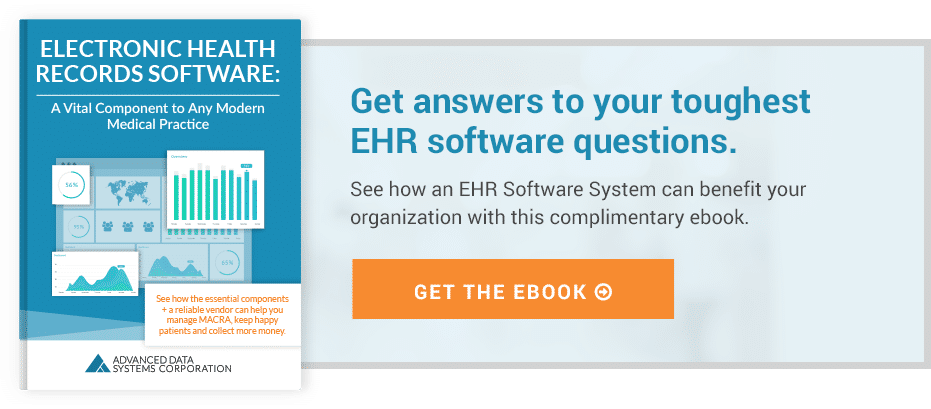Cloud-Based EHR vs. Client-Server EHR: 4 Key Differences
For the uninitiated, when someone in the medical community mentions “EHR,” he or she is talking about electronic health records.
An EHR is a vital application that is becoming nearly indispensable in most medical organizations, including those that treat Medicare and Medicaid patients and want to receive financial rewards from the government in exchange for demonstrating meaningful use of certified, up-to-date EHR technology because of the efficiencies it enables.
You store electronic records of each of your patients in the EHR, which can then be updated during each encounter. The information is kept safe and secure and when it needs to be transmitted to another party, such as a specialist making a consultation or when it comes time to provide details to insurers.
Get answers to your toughest EHR Software questions. See how a cloud-based EHR Software System will benefit your organization with our free ebook.
Stakeholders at leading medical practices know just how important it is to take advantage of the latest industry developments to better serve their patients. This goes for medical technology and its role in improving healthcare services as well as it does for the computer systems and software that keep medical practices up and running.
If your medical practices was founded before the modern era of affordable computer technology and broadband internet, chances are you made do with an old-fashioned paper based system to manage all of your patient records.
Or, you may be a more modern practice and your staff has been accustomed to using electronic health record or EHR software. However, now you are tasked with investigating your options for an EHR that is based in the cloud instead of on your own local data servers.
Anyone who has visited a medical technology trade show or who stays on top of industry developments and best practices will have noticed just how popular EHR systems have become over the last few years.
If you have yet to make the switch from a paper system to an EHR or are still uncertain about the best way forward from local storage to a cloud computing solution for your crucial patient records, you risk falling by the wayside. A bit of insight into modern EHR software may be just what you need during your decision making process.
Read on for a comparison of traditional EHR systems with cloud based EHR systems, so you can make a more informed decision when it comes time to upgrade your own practice’s EHR setup.
Difference #1: Customization and Ease of Use
A client-server EHR is software that your medical organization’s IT department is in charge of maintaining on local servers in your own data center. Technically speaking, this means that you are responsible for ensuring that all data is properly backed up on a regular basis, in multiple locations in case of a natural disaster affecting one of these storage facilities.
What’s more, your IT crew will have to predict how much server space and bandwidth you will need in the near future, such as when expanding the size of your team and patient pool, perhaps with new specialists coming on staff. When responsibility for maintaining software systems is local, you have to stay on top of urgent patches and upgrades, such as when the software developer issues a bug fix or takes care of a major flaw, and so on.
A local EHR will typically be more static and less easy to update when compared to a cloud-computing based EHR solution. But an EHR that’s based in the cloud is easily customizable with specialty-specific templates.
Convenience is another selling point, because with a cloud-based EHR, you can access the data from any location with Internet access, 24/7/365. This means data sharing and collaboration amongst your team will be much easier. In terms of personnel, you won’t need to allocate a full-time IT person for server maintenance.
Consider also how much time and effort you can save your physicians, nurse practitioners, RNs, and others by enabling them to access patient data via their portable device (tablet, smartphone, or laptop) when they happen to be away from the office.
A cloud based EHR means your professionals do not have to remain tethered to the physical office in order to provide answers about patient care. This means your team can use its time more effectively, and your patients will benefit too from the timelier access to information by their nurses and doctors during the course of diagnosis and treatments.
Difference #2: Security
Maintaining the integrity of your patients’ confidential and sensitive information should be among your highest priorities. Your patients trust you to protect them against criminal hackers bent on stealing their identity as well as their money. Mischievous pranksters might simply release patient data into the wild to cause chaos and fear, leaving you exposed to lawsuits for failing to maintain privacy in accordance with the Health Insurance Portability and Accountability Act.
Running a client-server setup means you always face the risk that data will be stolen, destroyed or even locked up until you pay a ransomware fine to hackers. Malware infecting your system or natural disasters are other unpredictable events that make hosting EHR data on local servers a messy proposition for many medical organizations. On the other hand, a cloud-based EHR’s data will be impossible to destroy, since there will always be multiple, redundant backups safely kept in distant locations.
Despite their best efforts and best practices being emphasized at the cloud computing services provider, there is still a potential risk for security malfunctions, but they will be less likely to occur there as they would in your own local data center.
Difference #3: Cost Effectiveness
When financing is tight, available revenue can definitely affect whether you adopt (or continue to maintain) a traditional client-server EHR system or go with a more modern and efficient cloud-based EHR solution.
“One of the largest detriments to a client-server system is the initial cost of EHR implementation. Since client-server systems require the installation of specific hardware and software throughout the medical office, some client-server systems can cost $40,000 or more just to set up,” noted a report from HIT Consultant.
Additional expenses are to be expected, the report continued. “In addition to the licensing fees, maintenance costs and updates that occur throughout the life of the system can be hard to swallow.”
It noted that because you do not have to pay for installing hardware on your end and you avoid licensing fees with a cloud based EHR, deploying an EHR in the cloud will be a mere fraction of the cost of hosting it on your own. Medical practices typically pay a comparatively low monthly fee to cover costs when the EHR is deployed in the cloud.
Difference #4: Upgrading of Each System
Any discussion of a new computer and software system has to account for the time, effort and other resources that will be required whenever an update is called for.
A traditional EHR does give you desirable benefits, including the ability to achieve complete control over security and data management. However, updating your legacy systems may involve you purchasing new software and computer equipment to keep up with technology as it evolves every few years.
The cloud computing services provider will maintain close watch over the system, ensuring it is updated immediately whenever needed. Your own IT team will not have to be burdened with such concerns and can devote more of its resources to vital, local computer systems that would benefit from such added attention and care now possible since freeing up IT from duties now handled by the cloud computing company.
Look for a software provider that demonstrates an excellent track record when it comes to updating its electronic health record software, both for security requirements and to meet any requirements of government or industry best practices. The cloud computing services provider you use should also have a stellar reputation, so do some basic investigation and conduct comparisons before making a commitment to a particular services provider.
Key Takeaway:
- Many medical practices have improved their workflow and efficiencies of their processes by switching from an antiquated paper-based system to using electronic health record or EHR software to handle all patient records.
- If you are still using a paper system or have found that a client-server EHR system is not the best approach for your particular practice, you and your stakeholders will want to consider going with a cloud-based EHR instead.
- Generally it is easier for a medical practice to customize a cloud-based EHR, using specialty-specific templates, than it is to customize a local, client-server EHR.
- Security can be more problematic when you are managing the EHR on your own servers. Outsourcing your data to the cloud provider means you benefit from their vigilant, round-the-clock security team.
- In terms of budgeting, it’s much cheaper to go the cloud computing route for your EHR, since your monthly costs will be a fraction of the typical $40,000 required in a client-server EHR setup.
- Upgrading your EHR will be a worry of the past, since the software can be updated whenever improvements are available. You will always access the latest version of EHR software when it’s hosted in the cloud.
If you are fairly new to learning about the impact of EHR systems and the nature of client-server EHRS vs. a cloud-based EHR, you’ll want to expand your perspective with the help of a trusted reference resource. As a service to our readers, we invite you to click here to download a copy of this free and informative e-book, “Electronic Health Records Software: A Vital Component to Any Modern Medical Practice.”
About Stephen O'Connor
Stephen O'Connor is the Director of Brand and Digital Marketing, responsible for many aspects of Advanced Data Systems Corporation’s (ADS) marketing, including product marketing, customer acquisition, demand generation, brand, brand design, and content marketing.
Stephen has more than 20 years of healthcare industry experience. Prior to ADS, Stephen spent 11 years at Medical Resources Inc. (MRI), most recently as the Manager of Marketing & Internet Services, where he and his teams were responsible for all marketing efforts and the market positioning of MRI’s services.
Stephen spends his day's planning, writing, & designing resources for the modern healthcare professional.








